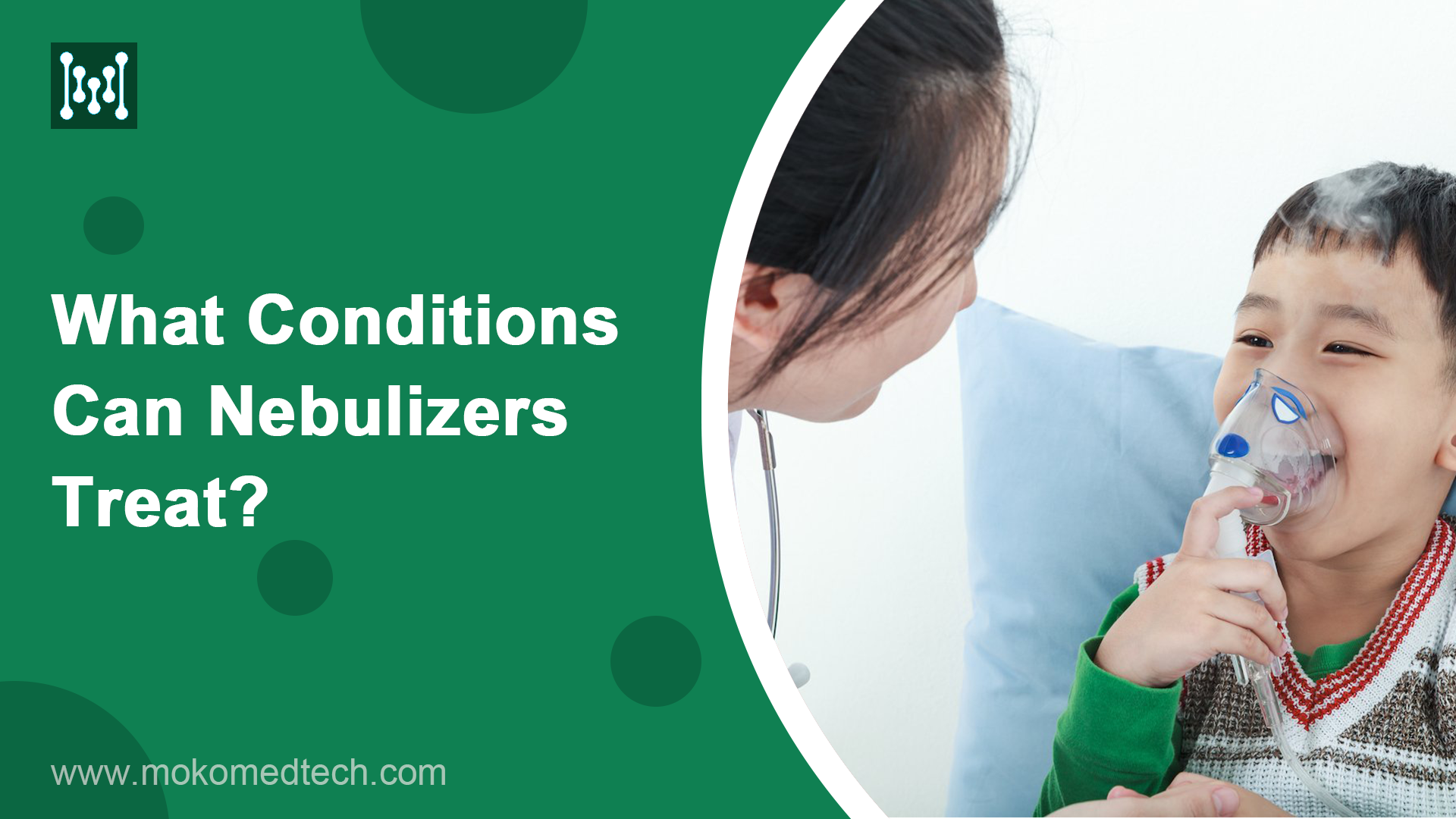In recent years, the world has been facing the challenge of the COVID-19 pandemic. This highly infectious virus has infected millions of people around the world and led to hundreds of thousands of deaths. Symptoms of COVID-19 include cough, fever, shortness of breath, etc. In severe cases, it may even lead to “Silent Hypoxia”, which is a potentially dangerous condition. This is why a pulse oximeter has become an important tool to monitor the blood oxygen situation in such cases and take timely measures to manage the situation. Although the global epidemic has now slowed down, there are still families who need to use this small device to detect the oxygen saturation of patients in such cases, so that they can quickly identify and respond to potential risks to patients.
For those who engage in regular physical activity, the use of an exercise bracelet can also be one way to monitor blood oxygen saturation. This device can measure blood oxygen saturation through a sensor on the wrist and the results can be viewed through a smartphone app. However, it is important to note that sports bracelets are usually not as accurate as professional oximeters, so it is recommended to use a professional pulse oximeter to monitor blood oxygen saturation.
What is A Pulse Oximeter?
1. Definition of Oximeter
A pulse oximeter is a non-invasive medical device used to measure the saturation of oxygen in a person’s blood. Oximeters typically consist of a sensor and a display. The sensor will clip onto a finger, earlobe, or other body part and uses infrared and photoelectric technology to measure the oxygen saturation in the blood.
Oxygen saturation is the percentage of hemoglobin in the blood that is bound by oxygen and is usually expressed as a percentage. Normally the body should have an oxygen saturation level of 95% or higher. Oximeters can help healthcare professionals monitor a patient’s blood oxygen level to determine if further treatment or intervention is needed. In-home healthcare, oximeters can also be used to monitor the health status of people with respiratory or other conditions. Especially with the COVID-19 pandemic, people need to be alert to the damage caused by silent hypoxia.
Pulse oximeters available on the market for monitoring blood oxygen come in different sizes and types depending on how they are used, the reading location, and the age and or size of the person. They can be divided into fingertip oximeters, handheld oximeters, benchtop oximeters, phone-based oximeters, wearables, and integrated oximeters.

2. Working Principle of Pulse Oximeter
The principle of operation of an oximeter is based on the principles of scattering and absorption of light. The oximeter contains an emitting light source and a receiver. The light source emits a beam of infrared and red light (mostly LEDs). As these lights pass through the skin and hit the venous vessels, they are absorbed or scattered. Red light is more readily absorbed by oxygen, while infrared light is less readily absorbed by oxygen.
By comparing the difference between the red and infrared light in the emitting source and the receiver, the oximeter can calculate the oxygen saturation in the blood. Specifically, the oximeter calculates oxygen saturation from the hemoglobin of the red blood cells in the blood. When the oxygen saturation in the blood is high, the hemoglobin absorbs more red light while scattering less infrared light. Conversely, when the blood is less saturated with oxygen, the hemoglobin absorbs less red light while scattering more infrared light.
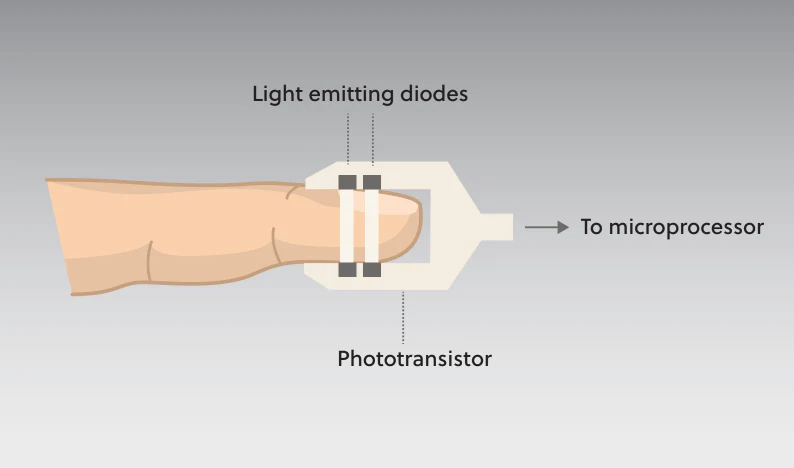
The chip used in oximetry typically contains an analog front end and a digital signal processor(DSP). The analog front end is responsible for amplifying and filtering the signals received from the transmitter and receiver. And then transmitting the signals to the digital signal processor for processing. The digital signal processor calculates the oxygen saturation based on the signal from the analog front end and displays the results on the oximeter’s screen.
What is Silent hypoxia?
Silent hypoxia, also known as “silent hypoxemia,” refers to a medical condition in which a person’s blood oxygen levels drop significantly without causing any noticeable symptoms or signs of breathing difficulty, such as shortness of breath or chest pain. It is a potentially dangerous condition because a person may not realize that their oxygen levels have dropped, which can lead to delayed treatment and potentially life-threatening complications.
Silent hypoxia can occur in various medical conditions, including COVID-19, pneumonia, pulmonary embolism, and other respiratory illnesses. The condition is typically diagnosed through blood oxygen level measurement using a pulse oximeter. If left untreated, silent hypoxia can cause organ damage or failure, brain damage, or even death.
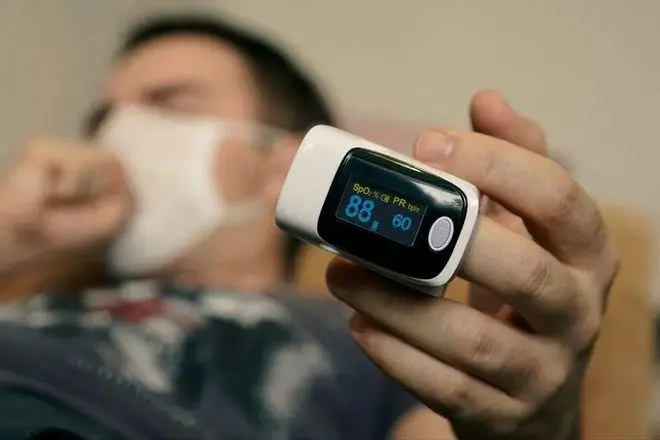
The risks associated with silent hypoxia include:
Organ Damage: Prolonged periods of low oxygen saturation can cause harm to critical organs such as the brain, heart, and kidneys, which rely heavily on an adequate oxygen supply to function properly.
Cognitive Impairment: Insufficient oxygen in the brain may lead to cognitive difficulties, memory loss, or even permanent brain damage if not addressed promptly.
Heart Complications: A decreased oxygen supply can strain the heart, causing irregular heartbeat, chest pain, or in severe cases, heart failure.
Acute Respiratory Distress Syndrome (ARDS): ARDS is a life-threatening lung condition that can develop due to silent hypoxia, particularly in patients with pre-existing respiratory illnesses like COVID-19.
Because silent hypoxia does not exhibit overt symptoms, it is crucial for individuals at risk, especially those with respiratory issues, to monitor their oxygen levels closely. Early detection can help prevent serious complications and improve patient outcomes.
Why Use A Pulse Oximeter?
Following are several reasons why someone or some families use a pulse oximeter, including:
1. Monitoring oxygen levels during medical procedures
A pulse oximeter is often used during medical procedures, such as surgery or anesthesia, to monitor a patient’s oxygen levels and ensure they are receiving enough oxygen.
2. Monitoring respiratory conditions
For people with respiratory conditions, such as chronic obstructive pulmonary disease (COPD) or asthma, a pulse oximeter can be a useful tool to monitor oxygen levels and adjust treatment as necessary. Also, some people may experience apnea during sleep, and a pulse oximeter can help them monitor breathing during sleep.
3. Monitoring COVID-19 symptoms
One of the symptoms of COVID-19 is a drop in oxygen levels, so a pulse oximeter can be a useful tool for people who have tested positive for COVID-19 and are self-monitoring their symptoms at home.
4. Monitoring heart and lung function
A pulse oximeter can also be used to monitor the function of the heart and lungs, particularly during exercise or physical activity. It can help identify any abnormalities in oxygen levels that may indicate an underlying heart or lung condition.
5. Monitoring altitude sickness
Altitude sickness can occur when a person travels to a high altitude, and their body struggles to adjust to the decreased oxygen levels. Pulse oximeters can monitor oxygen levels and help identify if someone is experiencing altitude sickness.
6. Monitoring carbon monoxide poisoning
Carbon monoxide can be deadly if inhaled in high concentrations. A pulse oximeter can be used to monitor oxygen levels in people who may have been exposed to carbon monoxide and help diagnose carbon monoxide poisoning.
How To Use A Pulse Oximeter Properly?
To ensure the most accurate readings when using an oximeter, here are some steps and guidelines to keep in mind:
- Ensure that any nail polish is removed before use;
- Ensure that the oximeter is properly placed on the finger or earlobe according to the manufacturer’s instructions and that the user’s hands or feet are warm, relaxed and kept below the level of the heart, as this may affect the accuracy of the reading;
- Do not move the body part where the pulse oximeter is located until the reading is complete and wait until the oximeter has stabilized and provided a steady reading. This may take a few seconds;
- Read the SpO2 (oxygen saturation) level, which is displayed as a percentage. Usually a healthy SpO2 level is between 95-100%.
- Read the pulse rate(PR), which is displayed as beats per minute. A normal resting pulse rate is between 60-100 beats per minute for adults.
- Compare the readings with the person’s normal baseline values, if available.
- If the oximeter readings seem inaccurate or inconsistent, try repositioning the device or using a different finger or earlobe.
- If you are still concerned about the accuracy of the oximeter readings, consult a medical professional.
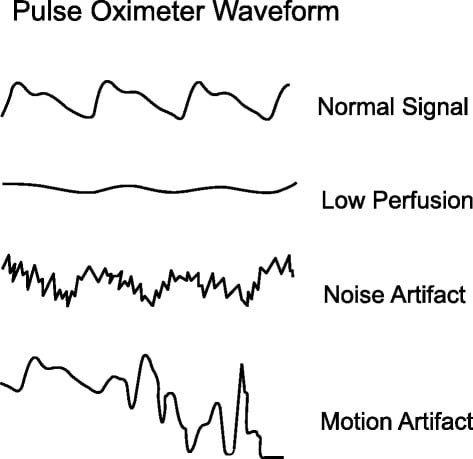
It is important to note that oximeters are imperfect and may not always provide accurate readings. Factors such as poor circulation, low blood pressure, and certain medical conditions can affect the accuracy of oximeter readings. Therefore, it is always best to consult a medical professional if you have any concerns about your oxygen saturation levels. For more reading, you can check FDA’s guidelines for pulse oximeter accuracy and limitations.
Extended Reading: Can a blood oxygen APP or Fitness tracker replace a pulse oximeter?
Blood oxygen machines for medical use must comply with the ISO80601-2-61:2017 specification, and can effectively distinguish between 70% and 100% blood oxygen concentration. However, in addition to medical blood oxygen machines and blood examinations, there are also many sports bracelets and blood oxygen apps that claim to have the function of detecting blood oxygen data. So, how accurate are these data?
Blood Oxygen APP
Take the Blood Oxygen APP as an example. When using it, you need to use your finger (usually the index finger) to cover the lens and flash of the mobile phone. The flash on the mobile phone will emit strong light, and then the lens will receive the pulse of the capillaries of the finger. APP will use Photoplethysmogram (PPG) to record the pulse of capillaries.
However, most general consumer mobile phones do not have infrared-sensitive devices, and cannot obtain the ratio of oxygenated hemoglobin like a blood oxygen machine. Therefore, most of these types of APP use self-developed algorithms to analyze the captured images. Signals of specific colors are filtered out to “simulate” the two wavelengths of the oximeter. The PPG optical principle needs to meet particularly stringent detection conditions in order to accurately obtain blood oxygen saturation. Factors such as wrist movement, skin temperature, fat thickness, blood vessels, and other factors will affect the blood oxygen monitoring accuracy of smartwatches. Therefore, we should consider the correct way of using the oximeter or smartwatch to avoid incorrect data.
At present, the accuracy and sensitivity of these simulation algorithms have not been approved by the FDA, so the reliability still cannot be used as a medical decision. Therefore, many smartwatch manufacturers say that the function of measuring blood oxygen in sports watches is not a problem for normal use, but there must be a gap compared with such professional medical devices as oximeters. At present, there are descriptions and labels on the details pages of major smart wearable devices with this function. For example, Apple’s Apple Watch product information clearly indicates that the blood oxygen monitoring function should not be used to replace professional medical diagnosis.
Smart Wearables
In addition to the blood oxygen APP, the sports bracelet imitates the specifications of the pulse meter, adding LEDs and sensors on the back of the watch.
Taking Apple Watch as an example, Apple Watch uses four LEDs on the back to emit red light, green light, and infrared light to illuminate the capillaries on the wrist, and then uses four sensors to receive reflected signals to measure blood oxygen.
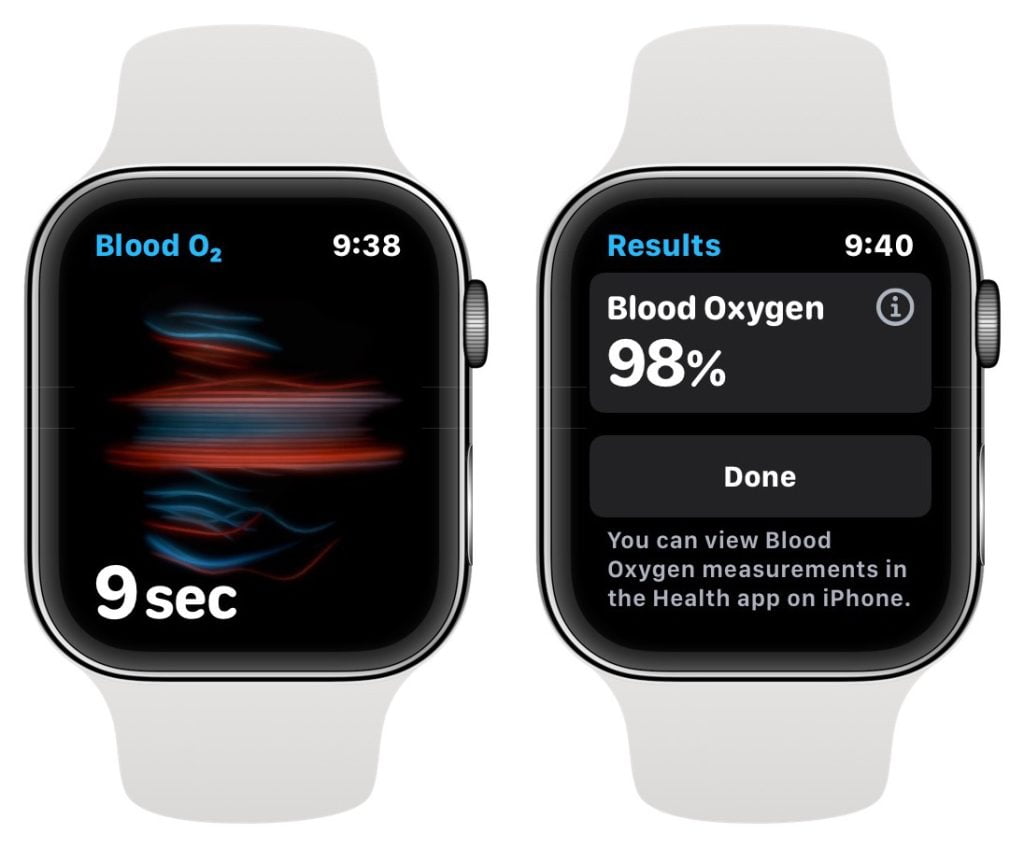
Different from the oximeter, when the sports bracelet detects blood oxygen, the watch must be close to the wrist, and factors such as skin color, wrist hair, the position where the watch is worn, the tightness of the strap, and the shaking during exercise, will affect the accuracy of the measurement, so it cannot be used for medical purposes at present.
Conclusion
All in all, although smart watches and blood oxygen Apps cannot replace oximeters, they are still very meaningful for health reference. At the same time, compared with traditional monitoring equipment, smartwatches can not only be used as decorations, but also provide continuous monitoring of blood oxygen, breathing, sleep, ECG, etc., which can bring certain reference values and save the need for multi-device inspection. The complex process reduces the cost of health monitoring and is more suitable for comprehensive home health management.

